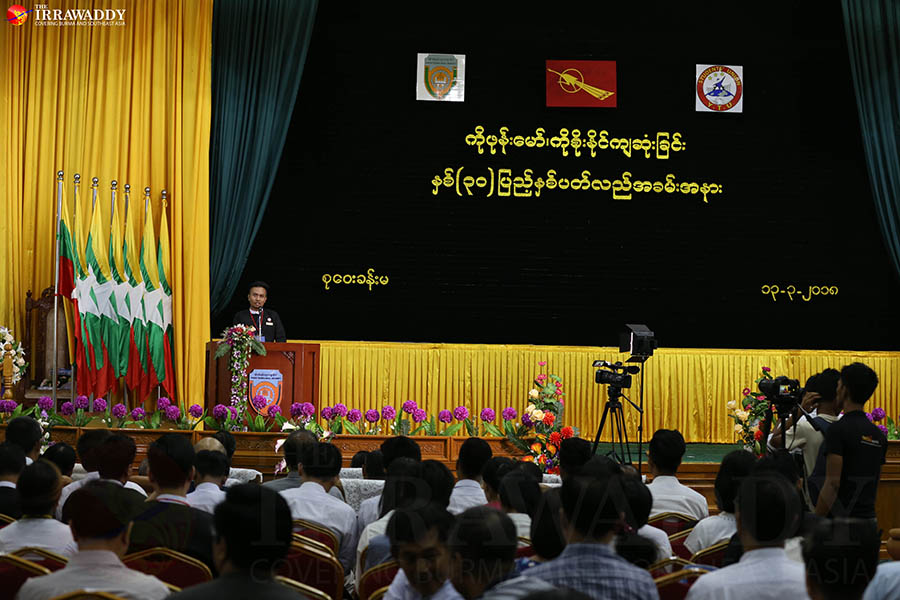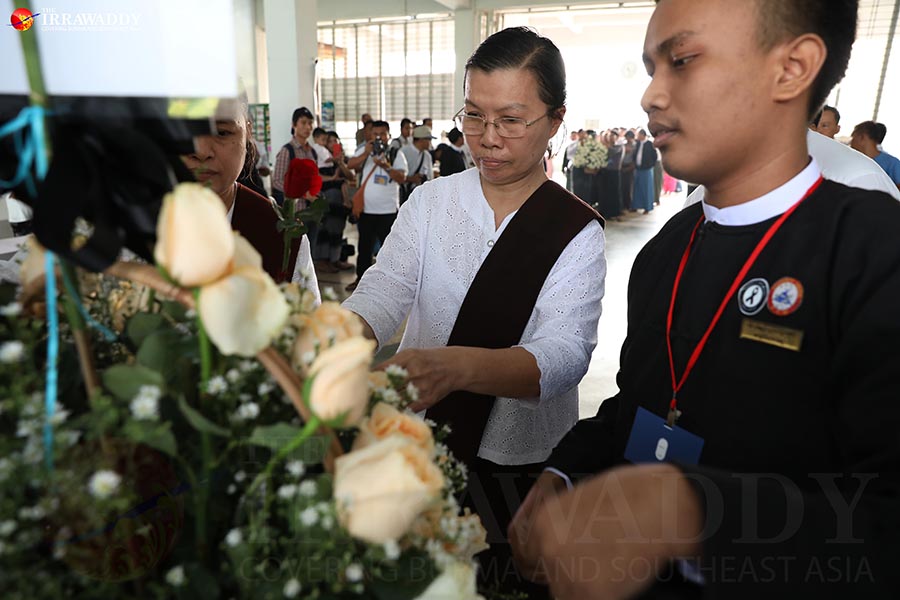YANGON — She used to wake her younger brother every day; for Daw Mar Mar Ei, it had become a morning ritual. But this pleasant routine came to an abrupt end one sultry summer day when she found herself staring at the young man’s dead body lying on a trolley in the bleak old concrete morgue of Yangon General Hospital.
“He looked as if were sleeping,” she said. “And peaceful.”
Standing there in the morgue, she was sandwiched between two plainclothes police officers, who held her tightly by the arms. One of them told her: “You should cry.”
“I shouted back at them: ‘I can’t! How can I cry when my brother was unjustly killed!’” the 55-year-old recalled of that fateful day 30 years ago when she first saw the dead body of her younger brother Ko Phone Maw, who was shot dead by riot police on the night of March 13, 1988 on the campus of the Rangoon Institute of Technology (now Yangon Technological University).
On Tuesday, the YTU Student Union commemorated the 30th anniversary of the deaths of Ko Phone Maw and Ko Soe Naing, who were also shot that night but died 23 days later of injuries sustained on the scene. Three other university students who were wounded survived.

On the evening of March 12, 1988, a group of RIT students got into a brawl with another group of young people from the neighborhood near the campus. The students were not pleased with the authorities’ handling of the case, and more clashes with local people erupted the next evening. A cordon of riot police wielding Remington shotguns raided the campus and opened fire on the students, who were also tear-gassed. Ko Phone Maw, a fifth-year Chemical Specialization student, was shot dead on the spot.
The killing and the way the security forces handled the case sparked anger; another student rally at RIT the next day soon spread to other campuses. Along with calls for justice in the shootings, they demanded the ouster of the Ne Win regime, which had been long despised by the people for its oppressive rule and economic mismanagement.
The regime responded to the demands with more brutality. On March 16, riot police cracked down violently on hundreds of students marching along the southern flank of Inya Lake, near the White Bridge bus stop, named after a small bridge spanning a culvert. A number of students — it is still unclear how many — were beaten to death. The site of the massacre was left so bloodied that it came to be known as “Red Bridge”.
Over the next five months, Myanmar witnessed a series of follow-up student protests sparked by the March 13 shooting, mostly in Yangon. These ultimately led to a nationwide popular uprising in August, known as the Four Eights Uprising, as it occurred on Aug. 8, 1988. The uprising saw thousands of deaths and arrests, but ended Ne Win’s 26-year-long single party rule and eventually paved the way for the political changes which allowed a democratically elected government to take power three decades later.
Dr. Maung Maung, Myanmar’s president at the time, remarked that 1988 was a year of upheaval, and one that that will long be marked as a turning point in the country’s history.
“The unfulfilled expectations of the people over the decades since the nation’s gaining back her freedom poured out on the streets in loud and angry outcry for change,” he writes in his book “The 1988 Uprising in Myanmar”.
“It was a storm of huge size and fierceness, and storms don’t just come; they build up and gather from different directions and then burst upon the scene.”
For Ko Ko Gyi, one of the prominent student leaders who took part in the uprising, the deaths of Ko Phone Maw and Ko Soe Naing formed a “spark that brought a huge change” to the country as well as for him personally.
“Were it not for their deaths and the ’88 Uprising, I wouldn’t have been a politician as I am today; probably a government official or trader,” he said. Thirty years ago today, he was a final-year student majoring in International Relations at Yangon University. He would be imprisoned on and off for his political activism until his most recent release in early 2012.
To honor the deaths of Ko Phone Maw and Ko Soe Naing, political activists in 2012 nominated March 13, the day the students were shot, as Myanmar Human Rights Day.
Daw Aung San Suu Kyi, who was Myanmar’s main opposition leader at the time, agreed with the proposal while commenting that “their deaths were caused by the lack of human rights in Myanmar.”
This year, the State Counsellor did not send a message in time for Wednesday’s commemoration, but last year she urged her fellow citizens to honor Ko Phone Maw and Ko Soe Naing along with other young people who sacrificed for the country, by making good efforts on behalf of Myanmar.

Daw Mar Mar Win, another sister of Ko Phone Maw, said at Tuesday’s commemoration that she was happy to see that people still remembered her brother.
Both sisters, who have for many years now spent much of their time at a meditation center, remembered their brother as a smart young man who hated violence and quarreling.
His death left their family traumatized, they said.
The authorities forced them to keep the funeral as low profile as possible. As the cause of death, the official death certificate says only: “Puncture wound (chest)”, and makes no reference to a gunshot.
Initially they were even forbidden from placing an obituary in the newspaper, though authorities eventually relented on this point after the family insisted.
They weren’t even left alone to conduct the funeral as they wished. The family was only allowed to see the body on the day before the cremation, for identification purposes. On the day of the funeral, March 17, the authorities secretly cremated the body at 8 AM at another cemetery, in an effort to avoid drawing public attention to the ceremony. At Tamwe Cemetery (which is no longer extant; the site later made way for a development project), the family members were not allowed to get out of their car or to say a final goodbye to their brother and son. All they could do was watch in tears through the front windscreen of their car as the unmarked coffin was swallowed by the flames.
Daw Mar Mar Win believes in the law of Karma, and that those who were responsible for her brother’s death will reap what they have sown. Likewise, the family believes that in death their brother and son was paying for his past sins and misdeeds; something from which nobody can escape.
“But we miss him. He is a good boy,” she said.

















